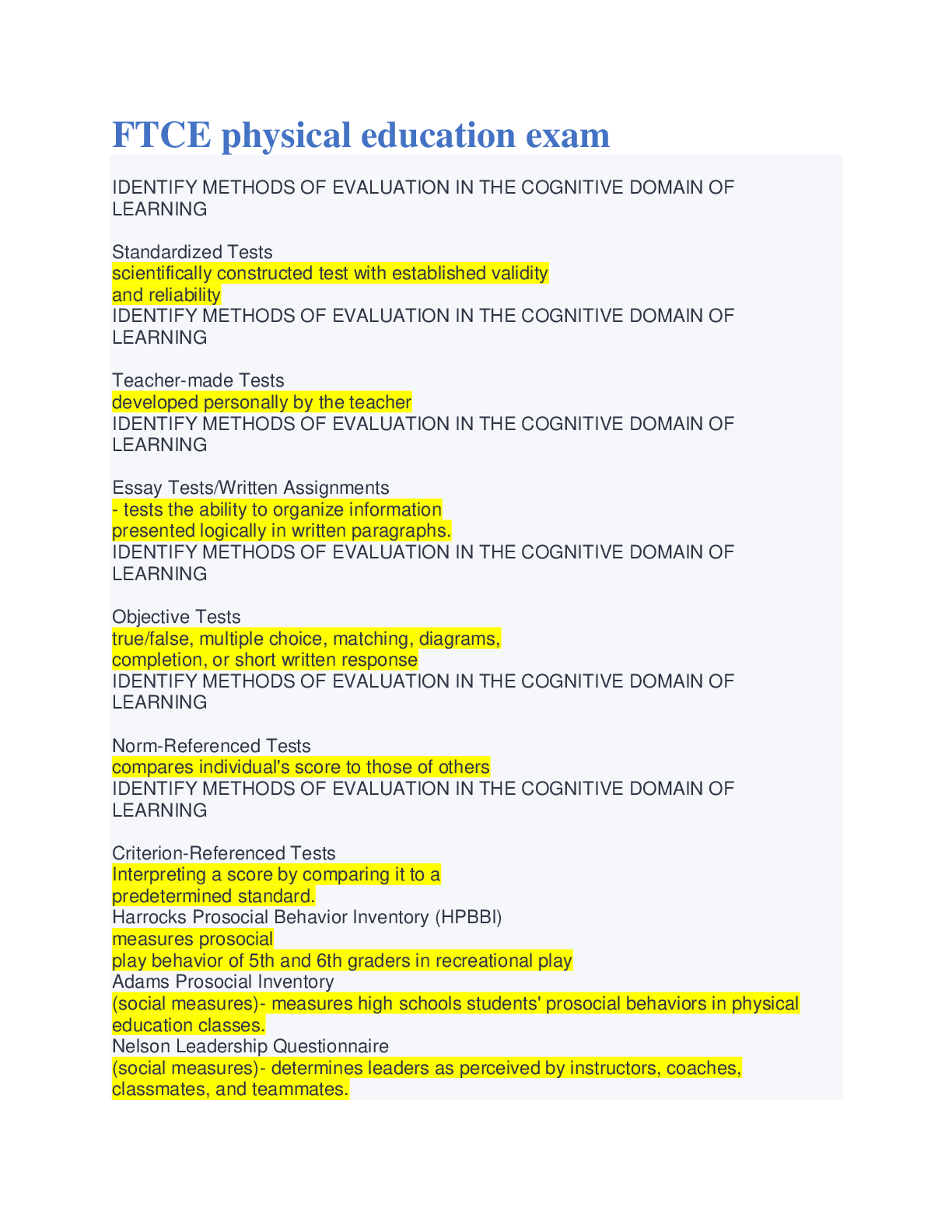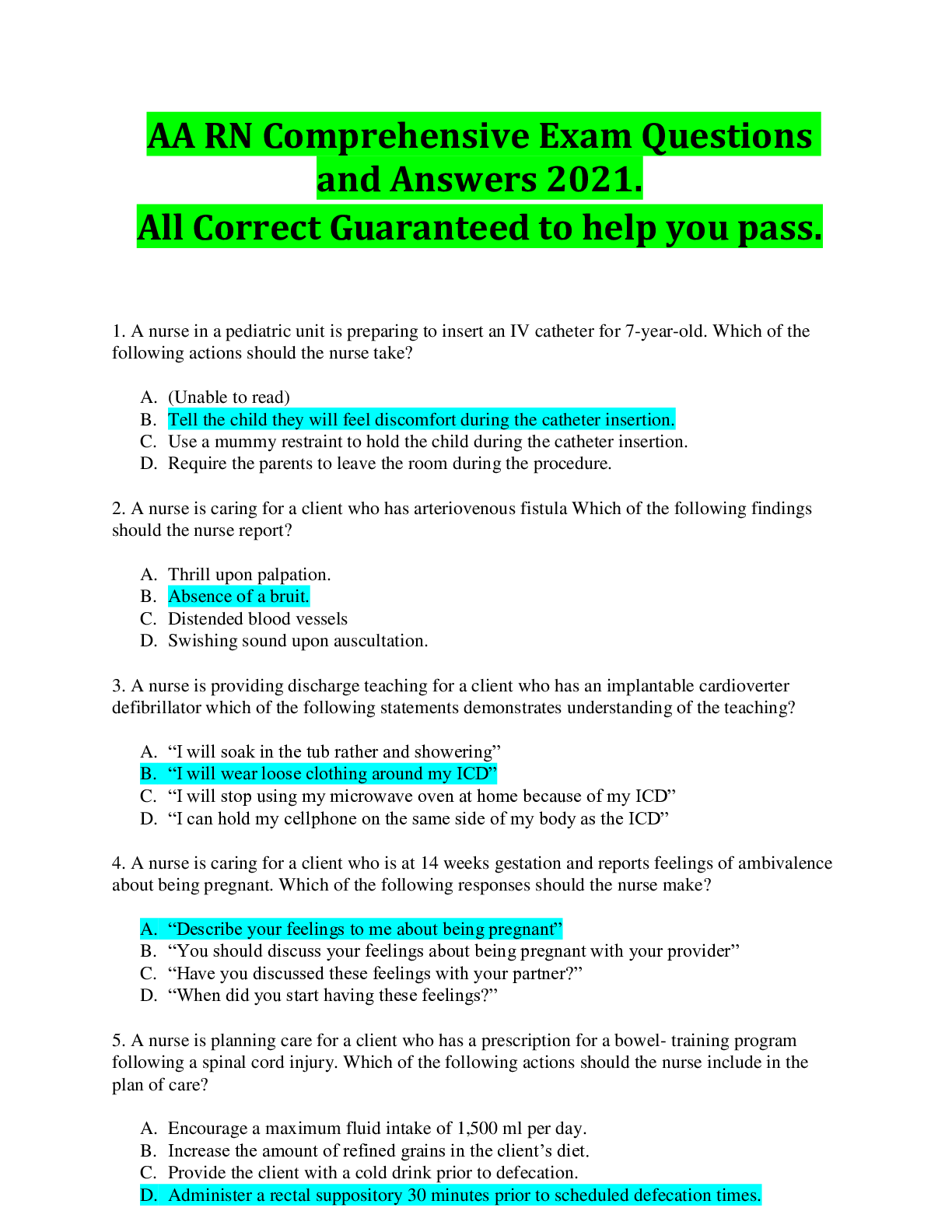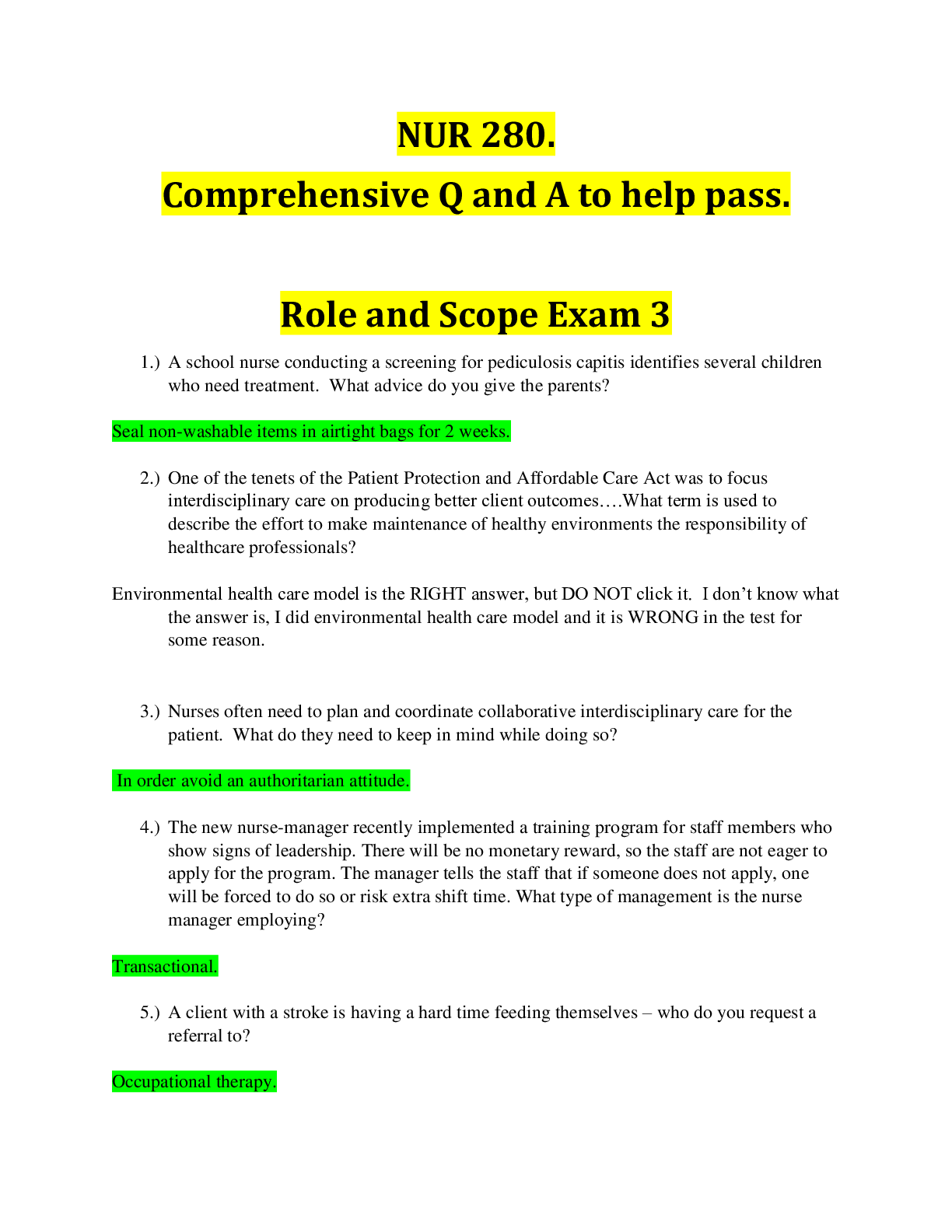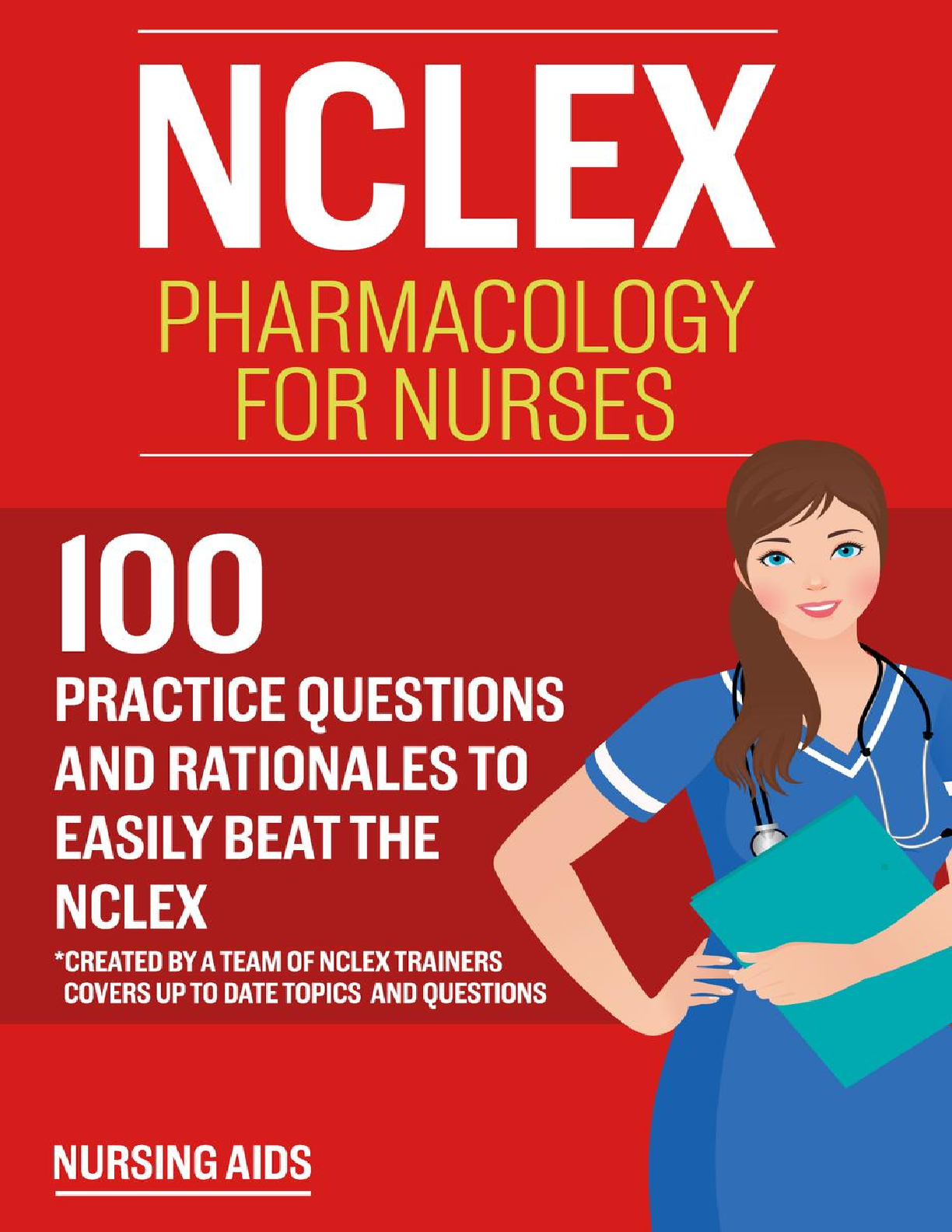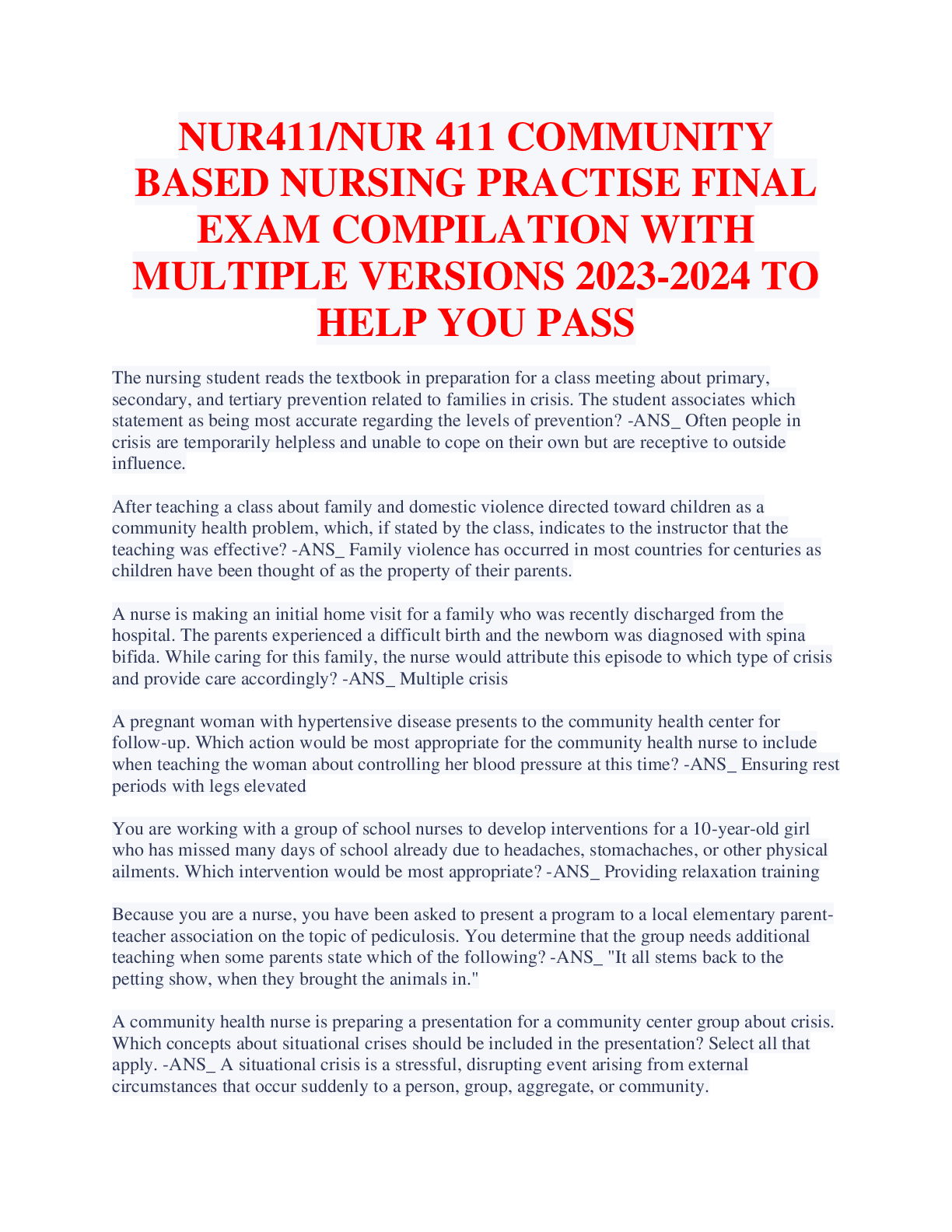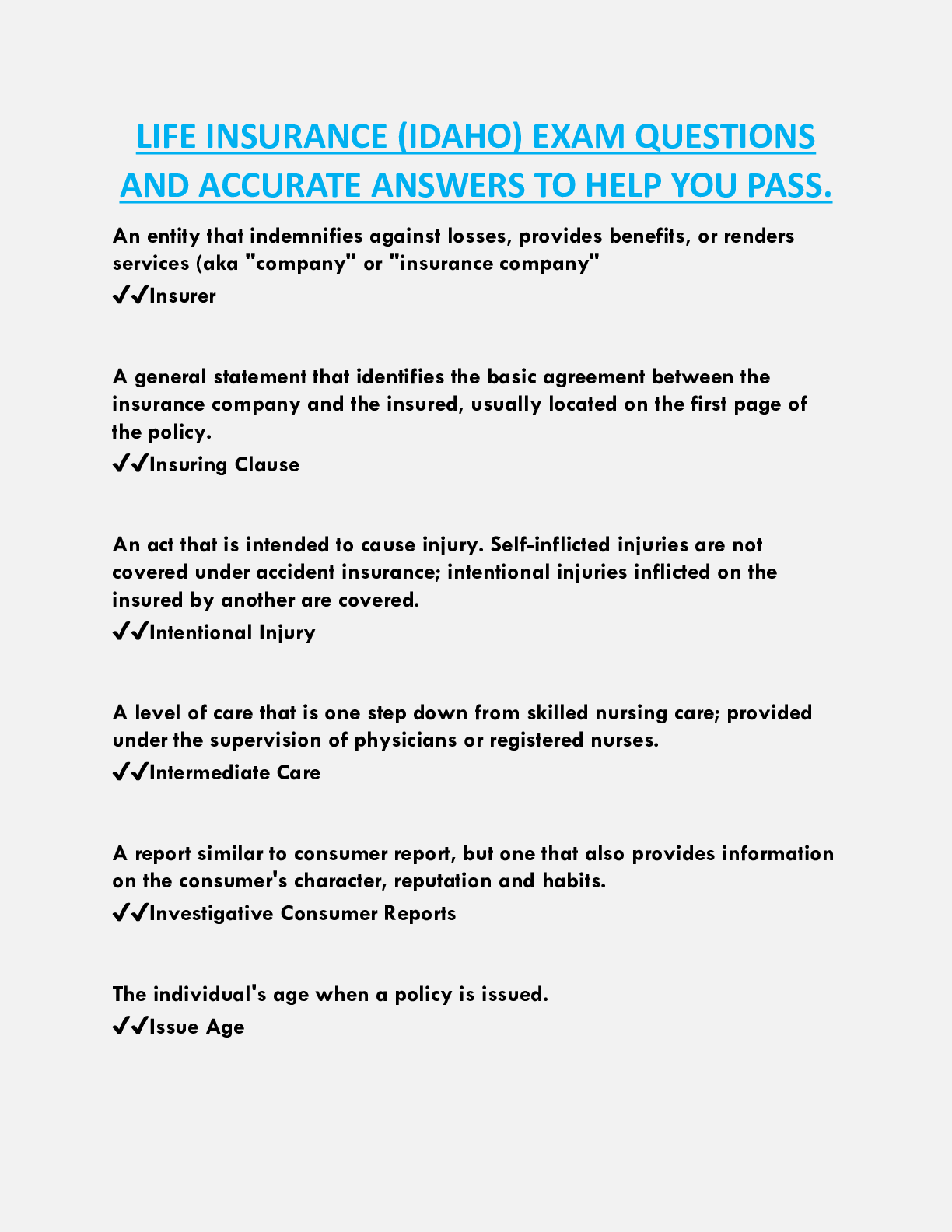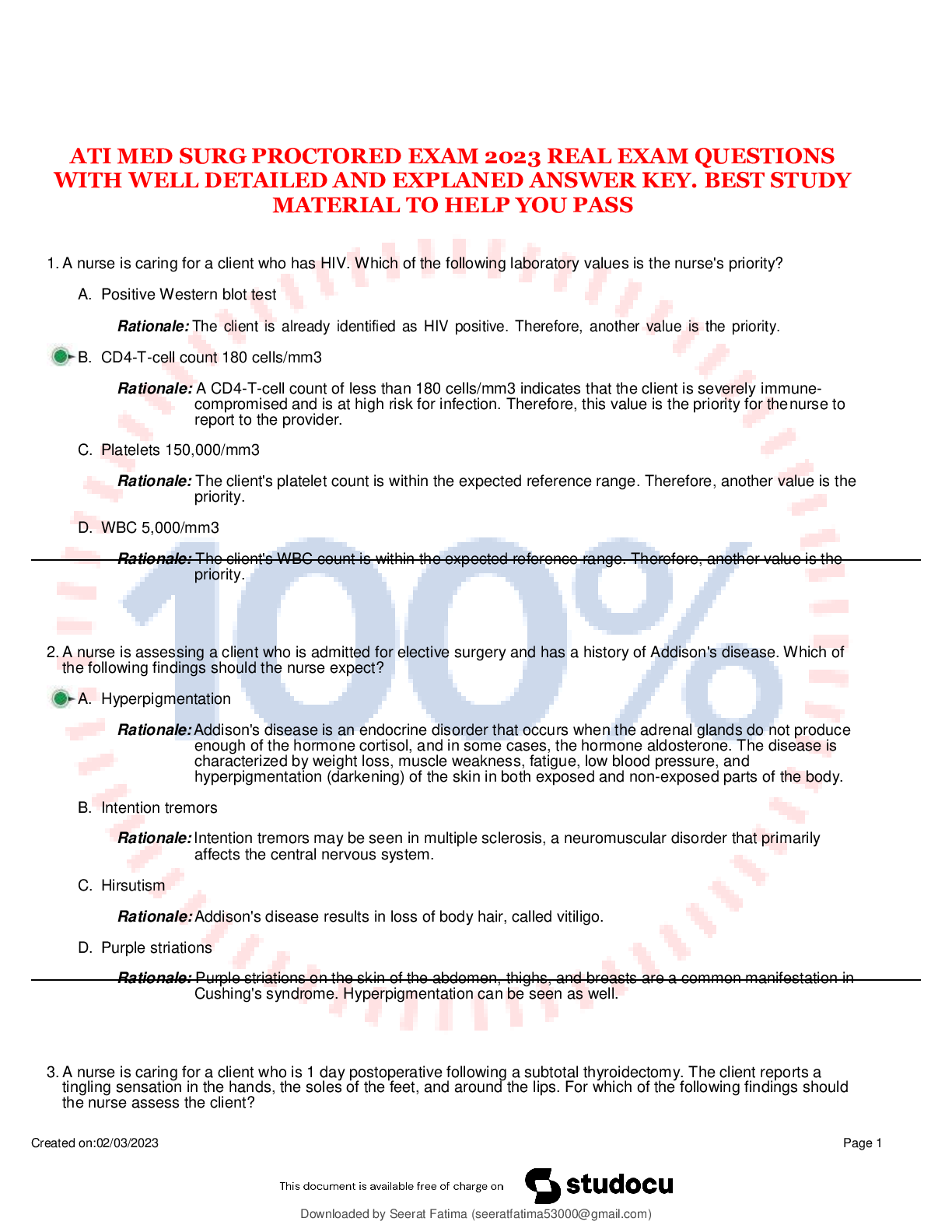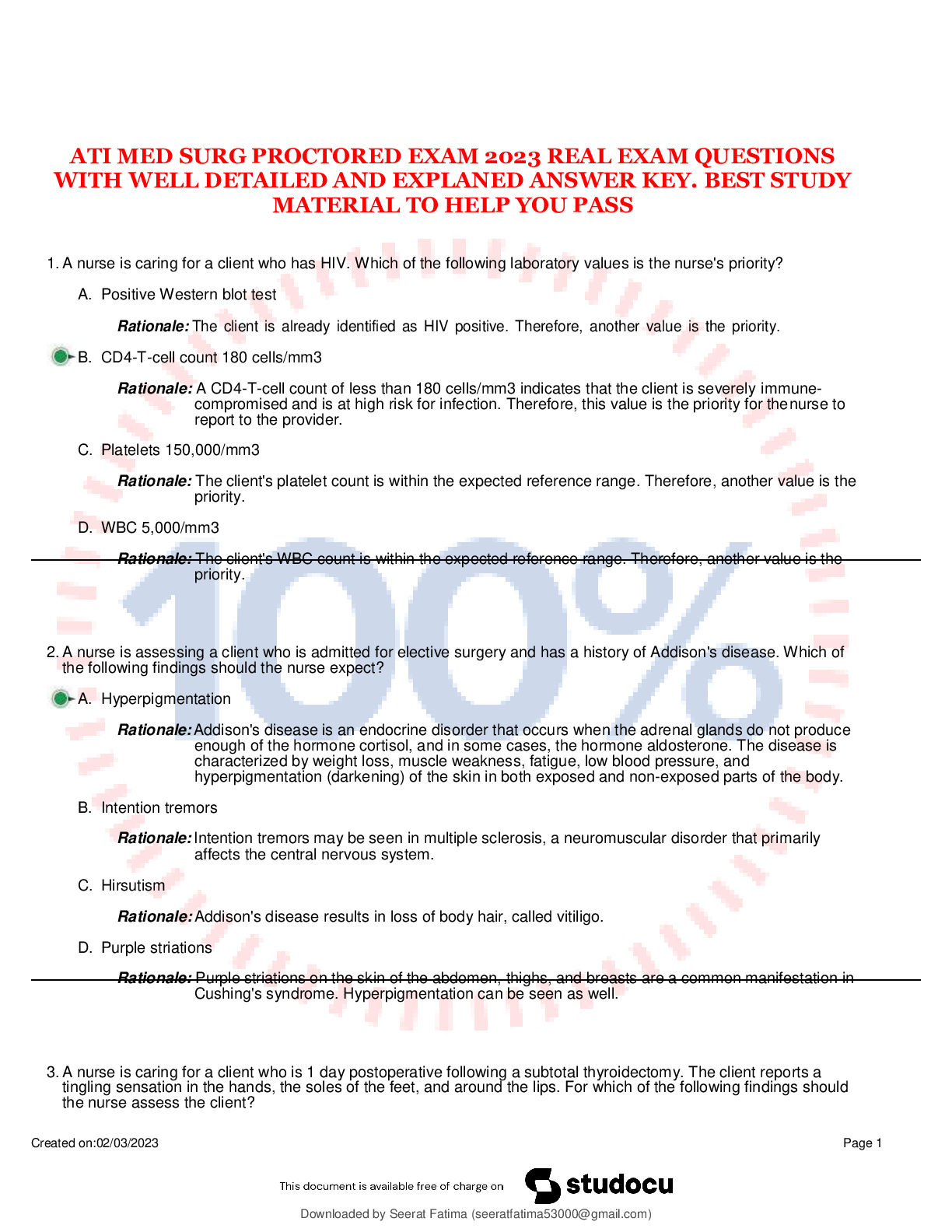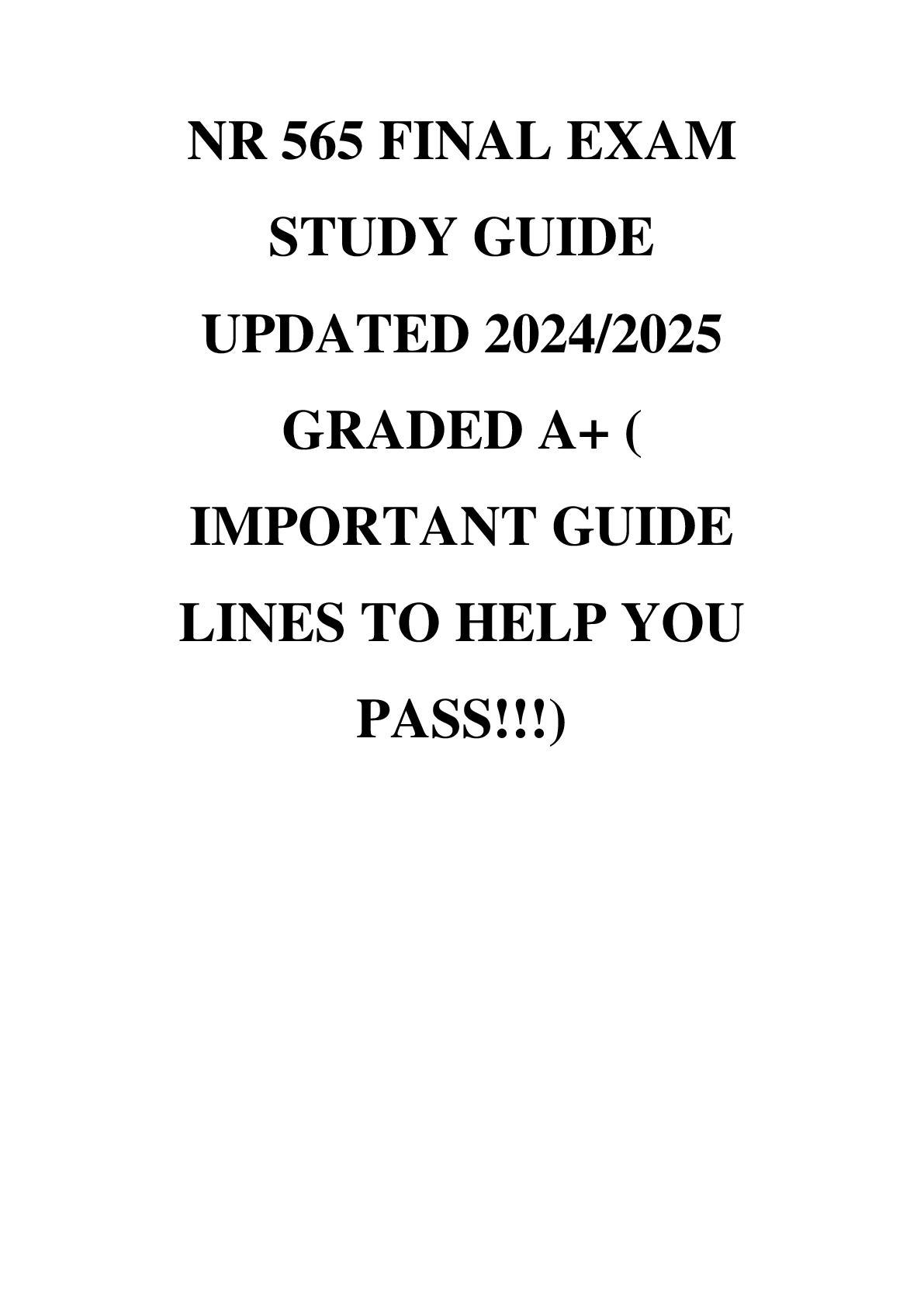Health Care > EXAM > HEALTH ASSESSMENT HESI (all in 1) designed to help you pass your exam. HEALTH ASSESSMENT HESI TEST B (All)
HEALTH ASSESSMENT HESI (all in 1) designed to help you pass your exam. HEALTH ASSESSMENT HESI TEST BANK; Fall 2022.
Document Content and Description Below
HEALTH ASSESSMENT HESI (all in 1) designed to help you pass your exam. HEALTH ASSESSMENT HESI TEST BANK; Fall 2022. Upon entering the client’s room at the beginning of a shift and throughout the s... hift, the nurse assesses the client. The nurse considers the client’s plan of care and response to nursing interventions during the assessments. What type of assessment is the nurse 1. performing? A) Ongoing partial assessment B) Comprehensive assessment C) Focused assessment D) Emergency assessment Ans : A Feedback: The nurse is performing an assessment on an infant. Which finding is considered an abnormal cardiovascular assessment that should be documented and reported to the 3. physician? A) Decreased heart rate B) Visible pulsation through a thin chest wall C) Sinus dysrhythmia that increases with inspiration and decreases with expiration Prime yourself for your Tests – StudyQuestions D) Presence of an S heart sound Ans : A Feedback: Infants and children should have a more rapid heart rate, instead of a decreased heart rate, until about age 8 years. Common cardiovascular findings include visible pulsation if the chest wall is thin, sinus dysrhythmia (the rate increases with inspiration and decreases with expiration), and the presence of an S heart sound. The nurse is conducting an assessment on the integumentary system of a client age 74 years. Which of the following findings should the nurse document as an anomaly that 4. may warrant follow-up? A) The client states that a mole on his forehead has become larger in recent months. B) Decreased skin turgor is evident when the skin is folded and then released. C) Small, round, red spots are present on the client’s forearms bilaterally. D) There are some raised, brown areas on the backs of the client’s hands. Ans : A Prime yourself for your Tests – StudyQuestions Feedback: Changes in the size or appearance of a mole always require further assessment and follow-up due to their association with skin cancer. Decreased skin turgor is an expected finding in older adults, as are diffuse red spots (cherry angioma) and raised, dark areas (senile lentigines). As a component of a head to toe assessment, the nurse is preparing to assess convergence 5. of the client’s eyes. How should the nurse conduct this assessment? A) Ask the client to follow her finger as she slowly moves it towards the client’s nose. Ask the client to look ahead while slowly bringing a pen light in from the side and to the B) client’s pupil. C) Ask the client to hold his head stationary while following a pencil from left to right. D) Ask the client to read a Snellen chart from a distance of 20 feet. Ans : A Feedback: Eye convergence is assessed by holding your finger 6″ to 8″ from the patient’s nose and asking the patient to follow it as it moves closer. A pen light is used to assess pupillary reaction. Visual acuity is assessed with the use of a Snellen chart. Following a pencil from side to side is a test for extraocular movements. 6. A nurse is conducting a health assessment. How will the information collected from the Prime yourself for your Tests – StudyQuestions client be used? A) As a basis for the nursing process B) To illustrate nursing competence C) To facilitate nurse–client caring D) As one component of medical care Ans : A Feedback: Health assessment is an integral component of nursing care and is the basis of the nursing process. Health assessments by nurses are used to plan, implement, and evaluate education and care. Nursing assessment is different from other types of health care provider assessments, as it is a holistic collection of information about a client’s level of health. A home health nurse is visiting a client who recently was hospitalized for repair of a fractured hip. The client tells the nurse, “I have had a lot of pain in my abdomen.” What 7. type of assessment would the nurse conduct? A) Comprehensive B) Ongoing partial Prime yourself for your Tests – StudyQuestions C) Focused D) Emergency Ans : C Feedback: A focused assessment is conducted to assess a specific problem. In this case, the nurse would ask the client about urinary frequency, bowel movements, and diet, and then take vital signs and assess the abdomen. Comprehensive assessments include a detailed health history and physical assessment. Ongoing partial assessments are conducted at regular intervals, and emergency assessments are carried out in emergency situations (such as prior to CPR). An adolescent comes to a community health clinic with complaints of vaginal itching and discharge. She believes it is from having sex with her boyfriend. Which response should 8. the nurse use during the health history to elicit information? A) “Tell me about the sexual activity with your boyfriend.” B) “Why did you ever have sex with someone you don’t know?” C) “You are old enough to know to use condoms.” D) “I don’t understand how you could be so careless.” Prime yourself for your Tests – StudyQuestions Ans : A Feedback: The health history is used to collect subjective data about the client’s health status. Nurses use therapeutic communication skills, including open-ended statements and questions that are not threatening or negative, to establish an effective nurse–client relationship that facilitates communication. A nurse is preparing a client for a physical assessment. The client appears anxious about 9. the assessment. Which statement by the nurse would be most appropriate? A) “This is nothing to worry about. I won’t hurt you.” B) “Some of the examination may be painful, but I will be gentle.” C) “Let me tell you what I will be doing. It should not be painful.” D) “I have to do this, so just relax and it won’t last long.” Ans : C Feedback: The client may be anxious for many reasons. Tell the client that the assessments should not be painful. Explaining the assessment in general terms can help decrease the client’s embarrassment, fear of possible abnormal physical findings, or fear of “failing” a test. Prime yourself for your Tests – StudyQuestions 10. What would a nurse ensure before beginning a health assessment? A) That the time needed for the assessment fits into the nurse’s work schedule B) That the room is private, quiet, warm, and has adequate light C) That family members are present to answer specific questions D) That there is a written physician’s order for the assessment Ans: B When using assessment equipment that will touch the client, what should the nurse do 12. before conducting the assessment? A) Describe the equipment and how it works. B) Show pictures of functions of the equipment. C) Draw pictures of the anatomy to be assessed. D) Warm the equipment with hands or warm water. Ans D Prime yourself for your Tests – StudyQuestions : Feedback: Equipment that will touch the client during a physical examination should be warmed by the examiner’s hands or warm water before use. A school nurse is preparing to test the auditory function of grade school students. What 13. equipment will be needed for this examination? A) Tuning fork B) Percussion hammer C) Speculum D) Ophthalmoscope Ans : A Feedback: A tuning fork is a two-pronged metal instrument used to test auditory function and vibratory perception. The fork is activated to vibrate by holding the base and gently tapping the prongs against the palm of the examiner’s hand. Once vibrating, the fork is held at the base to avoid diminishing the vibration. Prime yourself for your Tests – StudyQuestions A nurse is preparing to examine the breasts of a client. In what position should the nurse 14. place the client? A) Prone B) Standing C) Dorsal recumbent D) Lithotomy Ans : C Feedback: The dorsal recumbent position is used to assess the head, neck, anterior thorax, lungs, heart, breasts, extremities, and peripheral pulses. The prone position is used to assess the hip joint and posterior thorax. The standing position is used to assess posture, balance, and gait. The lithotomy position is used to assess female genitalia and rectum. A nurse is using inspection as an assessment technique. What does the nurse use during 15. inspection? A) Equipment such as a stethoscope B) Both hands to produce sounds Prime yourself for your Tests – StudyQuestions C) Light palpation to detect surfaces D) Senses of vision, hearing, smell Ans : D Feedback: Inspection is the process of performing deliberate, purposeful observations. The nurse observes visually but also uses hearing and smell to gather data throughout the assessment. A stethoscope is used for auscultation, and the hands are used to percuss and palpate. 16. Which of the following can a nurse assess by palpation? A) Heart sounds, lung sounds, blood pressure B) Temperature, turgor, moisture C) Vision, hearing, cranial nerves D) Tissue density, gait, reflexes Ans : B Feedback: Prime yourself for your Tests – StudyQuestions Palpation is an assessment technique that uses the sens [Show More]
Last updated: 2 years ago
Preview 1 out of 260 pages

Buy this document to get the full access instantly
Instant Download Access after purchase
Buy NowInstant download
We Accept:

Reviews( 0 )
$20.00
Can't find what you want? Try our AI powered Search
Document information
Connected school, study & course
About the document
Uploaded On
Aug 19, 2022
Number of pages
260
Written in
Additional information
This document has been written for:
Uploaded
Aug 19, 2022
Downloads
0
Views
53












